All publications. Click above to see publications for a given project.

|
|
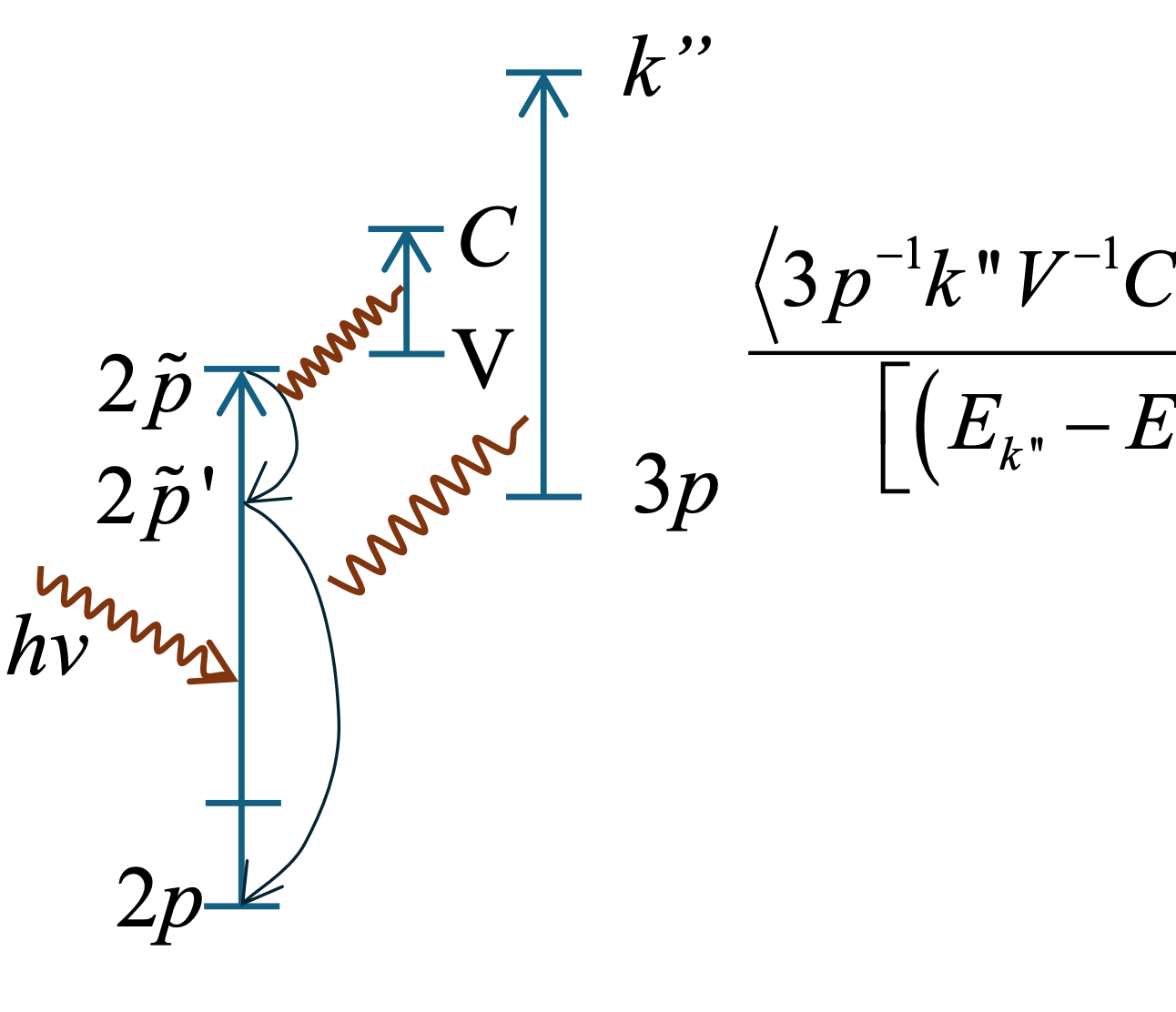
|
A new approach—termed the Narrow Shirley background—is introduced for analyzing the intrinsic background in X-ray photoelectron spectroscopy (XPS). In XPS, the photoemission signal comprises extrinsic and intrinsic contributions. The extrinsic signal, also known as the inelastic background or Tougaard background, arises from electrons that lose energy after excitation through inelastic scattering events before reaching the spectrometer. This background component dominates at higher binding energies, typically around 60 eV from the main photoemission peak. Conversely, the intrinsic signal originates primarily during photon absorption and encompasses the remaining features, including photoelectron peaks, Auger peaks, and the intrinsic background. While the well-known Shirley background describes the intrinsic background in the near-peak region, a significant part of the intrinsic background extends to higher binding energies. This extended background exhibits a rich structure, particularly in spectra from third and fourth-row metals. This paper proposes the Interchannel Coupling with Valence Band Losses (ICVBL) mechanism as the underlying origin of the entire intrinsic background, extending its role beyond the near-peak region (i.e., the Shirley background) as previously suggested [10.1002/sia.6364]. The Narrow-Shirley background is similar to the Shirley background in the near-peak region; still, it decays at higher binding energy to allow for incorporating other peaks to describe the structure of the intrinsic background. Besides focusing on the Narrow-Shirley background, this paper discusses the broader implications of the ICVBL mechanism in understanding intrinsic background structure.
|
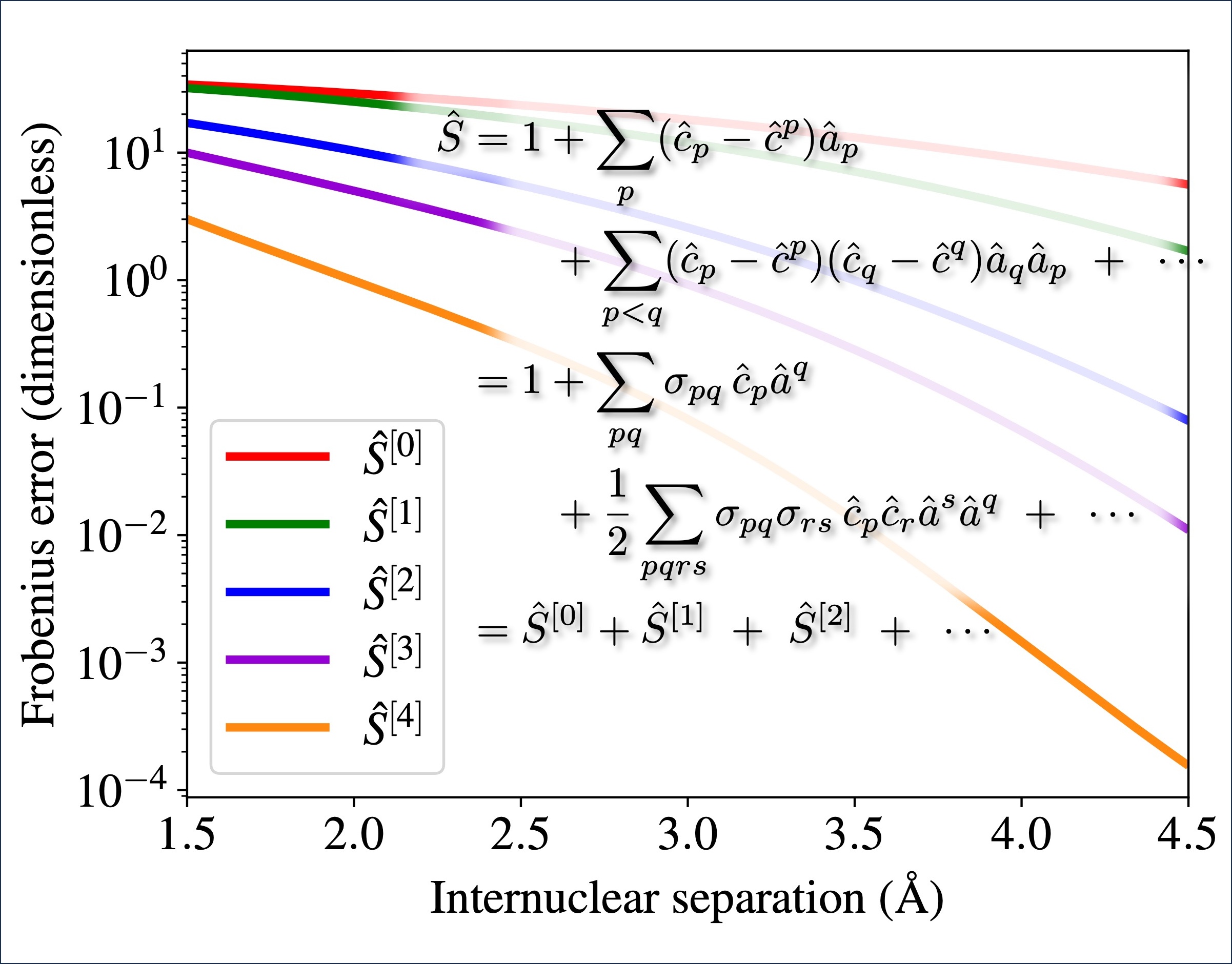
|
Utilizing the sparsity of the electronic structure problem, fragmentation methods have been researched for decades with great success, pushing the limits of ab initio quantum chemistry ever further. Recently, this set of methods has been expanded to include a fundamentally different approach called excitonic renormalization, providing promising initial results. It builds a supersystem Hamiltonian in a second-quantized-like representation from transition-density tensors of isolated fragments, contracted with biorthogonalized molecular integrals. This makes the method fully modular in terms of the quantum chemical methods applied to each fragment and enables massive truncation of the state-space required. Proof-of-principle tests have previously shown that an excitonically renormalized Hamiltonian can efficiently scale to hundreds of fragments, but the ad hoc approach to building the Hamiltonian was not scalable to larger fragments. On the other hand, initial tests of the originally proposed modular Hamiltonian build, presented here, show the accuracy to be poor on account of its non-Hermitian character. In this study, we bridge the gap between these with an operator expansion that is shown to converge rapidly, tending toward a Hermitian Hamiltonian while retaining the modularity, yielding an accurate, scalable method. The accuracy is tested here for a beryllium dimer. At distances near equilibrium and longer, the zeroth-order method is comparable to coupled-cluster singles, doubles, and perturbative triples and the first-order method is comparable to full configuration interaction (FCI). The second-order method agrees with FCI for distances well up the inner repulsive wall of the potential. Deviations occurring at shorter bond distances are discussed along with approaches to scaling to larger fragments.
|

|
This article proposes a random-forest based A2Cloud framework to match scientific applications with Cloud providers and their instances for high performance. The framework leverages four engines for this task: PERF engine, Cloud trace engine, A2Cloud-ext engine, and the random forest classifier (RFC) engine. The PERF engine profiles the application to obtain performance characteristics, including the number of single-precision (SP) floating-point operations (FLOPs), double-precision (DP) FLOPs, x87 operations, memory accesses, and disk accesses. The Cloud trace engine obtains the corresponding performance characteristics of the selected Cloud instances including: SP floating point operations per second (FLOPS), DP FLOPS, x87 operations per second, memory bandwidth, and disk bandwidth. The A2Cloud-ext engine uses the application and Cloud instance characteristics to generate objective scores that represent the application-to-Cloud match. The RFC engine uses these objective scores to generate two types of random forests to assist users with rapid analysis: application-specific random forests (ARF) and application-class based random forests. The ARF consider only the input application’s characteristics to generate a random forest and provide numerical ratings to the selected Cloud instances. To generate the application-class based random forests, the RFC engine downloads the application profiles and scores of previously tested applications that perform similar to the input application. Using these data, the RFC engine creates a random forest for instance recommendation. We exhaustively test this framework using eight real-world applications across 12 instances from different Cloud providers. Our tests show significant statistical agreement between the instance ratings given by the framework and the ratings obtained via actual Cloud executions.
|

|
A generalized variant of coupled-cluster theory is described here, wherein the degrees of freedom are fluctuations of fragments between internally correlated states. The effects of intra-fragment correlation on the inter-fragment interaction are pre-computed and permanently folded into an effective Hamiltonian, thus avoiding many redundant evaluations of local relaxations associated with coupled fluctuations. A companion article shows that the electronic Hamiltonians of real systems may always be cast in the form required. Two proof-of-principle demonstrations are presented. One uses harmonic oscillators, for which accuracy and algorithm structure can be carefully controlled in comparisons. The other uses small electronic systems to demonstrate compelling accuracy and efficiency, also when inter-fragment electron exchange and charge transfer must be handled. This framework opens a promising path to build finely tunable, systematically improvable methods to capture precise properties of systems interacting with a large number of other systems. Since this scheme is independent of the quality of the states used for the fragments, it can be arbitrarily detailed in terms of the correlation model used for each. The extension to excited states is also straightforward.
|
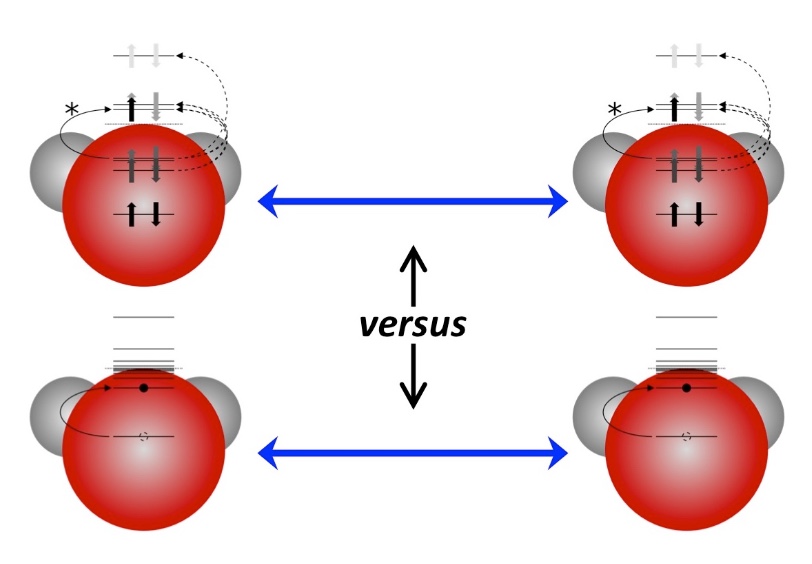
|
We show here that the Hamiltonian for an electronic system may be written exactly in terms of fluctuation operators that transition constituent fragments between internally correlated states, accounting rigorously for inter-fragment electron exchange and charge transfer. Familiar electronic structure approaches can be applied to the renormalized Hamiltonian. For efficiency, the basis for each fragment can be truncated, removing high-energy local arrangements of electrons from consideration, and effectively defining collective coordinates for the fragments. For a large number of problems, this has the potential to fold the majority of electron correlation into the effective Hamiltonian, and it should provide a robust approach to incorporating difficult electronic structure problems into large systems. The number of terms in the exactly transformed Hamiltonian formally scales quartically with system size, but this can be reduced to quadratic in the mesoscopic regime, to within an arbitrary error tolerance. Finally, all but a linear-scaling number of these terms may be efficiently decomposed in terms of electrostatic interactions between a linear-scaling number of pre-computed transition densities. In a companion article, this formalism is applied to an excitonic variant of coupled-cluster theory.
|

|
The background in X-ray photoelectron spectroscopy data originates, partially, from inelastically scattered photoelectrons. In fact, the current theoretical methods for calculating the background intensity are based on electron energy losses. However, a critical part of the experimental signal, which is known as the Shirley background, cannot be described within the current formalisms. This suggests that the Shirley electrons are not associated with energy losses of photoelectrons and must originate from a different photoexcitation phenomenon with a cross section of its own. We propose a mechanism based on core channeling as the physical origin of the Shirley signal.
|

|
Femtosecond and attosecond X-ray transient absorption experiments are becoming increasingly sophisticated tools for probing nuclear dynamics. In this work, we explore and develop theoretical tools needed for interpretation of such spectra, in order to characterize the vibrational coherences that result from ionizing a molecule in a strong IR field. Ab initio data for F2 is combined with simulations of nuclear dynamics, in order to simulate time-resolved X-ray absorption spectra for vibrational wavepackets after coherent ionization at 0 K and at finite temperature. Dihalogens pose rather difficult electronic structure problems, and the issues encountered in this work will be reflective of those encountered with any core–valence excitation simulation when a bond is breaking. The simulations reveal a strong dependence of the X-ray absorption maximum on the locations of the vibrational wave packets. A Fourier transform of the simulated signal shows features at the overtone frequencies of both the neutral and the cation, which reflect spatial interferences of the vibrational eigenstates. This provides a direct path for implementing ultrafast X-ray spectroscopic methods to visualize coherent nuclear dynamics.
|
23. Advances in Molecular Quantum Chemistry contained in the Q-Chem 4 Program Package
Y. Shao, Z. Gan, E. Epifanovsky, A. T. B. Gilbert, M. Wormit, J. Kussmann, A. W. Lange, A. Behn, J. Deng, X. Feng, D. Ghosh, M. Goldey, P. R. Horn, L. D. Jacobson, I. Kaliman, R. Z. Khaliullin, T. Kuś, A. Landau, J. Liu, E. I. Proynov, Y. M. Rhee, R. M. Richard, M. A. Rohrdanz, R. P. Steele, E. J. Sundstrom, H. L. Woodcock III, P. M. Zimmerman, D. Zuev, B. Albrecht, E. Alguire, B. Austin, G. J. O. Beran, Y. A. Bernard, E. Berquist, K. Brandhorst, K. B. Bravaya, S. T. Brown, D. Casanova, C.-M. Chang, Y. Chen, S. H. Chien, K. D. Closser, D. L. Crittenden, M. Diedenhofen, R. A. DiStasio Jr., H. Do, A. D. Dutoi, R. G. Edgar, S. Fatehi, L. Fusti-Molnar, A. Ghysels, A. Golubeva-Zadorozhnaya, J. Gomes, M. W. D. Hanson-Heine, P. H. P. Harbach, A. W. Hauser, E. G. Hohenstein, Z. C. Holden, T.-C. Jagau, H. Ji, B. Kaduk, K. Khistyaev, J. Kim, J. Kim, R. A. King, P. Klunzinger, D. Kosenkov, T. Kowalczyk, C. M. Krauter, K. U. Lao, A. Laurent, K. V. Lawler, S. V. Levchenko, C. Y. Lin, F. Liu, E. Livshits, R. C. Lochan, A. Luenser, P. Manohar, S. F. Manzer, S.-P. Mao, N. Mardirossian, A. V. Marenich, S. A. Maurer, N. J. Mayhall, E. Neuscamman, C. M. Oana, R. Olivares-Amaya, D. P. O'Neill, J. A. Parkhill, T. M. Perrine, R. Peverati, A. Prociuk, D. R. Rehn, E. Rosta, N. J. Russ, S. M. Sharada, S. Sharma, D. W. Small, A. Sodt, T. Stein, D. Stück, Y.-C. Su, A. J. W. Thom, T. Tsuchimochi, V. Vanovschi, L. Vogt, O. Vydrov, T. Wang, M. A. Watson, J. Wenzel, A. White, C. F. Williams, J. Yang, S. Yeganeh, S. R. Yost, Z.-Q. You, I. Y. Zhang, X. Zhang, Y. Zhao, B. R. Brooks, G. K. L. Chan, D. M. Chipman, C. J. Cramer, W. A. Goddard III, M. S. Gordon, W. J. Hehre, A. Klamt, H. F. Schaefer III, M. W. Schmidt, C. D. Sherrill, D. G. Truhlar, A. Warshel, X. Xu, A. Aspuru-Guzik, R. Baer, A. T. Bell, N. A. Besley, J.-D. Chai, A. Dreuw, B. D. Dunietz, T. R. Furlani, S. R. Gwaltney, C.-P. Hsu, Y. Jung, J. Kong, D. S. Lambrecht, W. Liang, C. Ochsenfeld, V. A. Rassolov, L. V. Slipchenko, J. E. Subotnik, T. Van Voorhis, J. M. Herbert, A. I. Krylov, P. M. W. Gill and M. Head-Gordon
[Mol. Phys. 113 184 (2015)]
|

|
A summary of the technical advances that are incorporated in the fourth major release of the Q-Chem quantum chemistry program is provided, covering approximately the last seven years. These include developments in density functional theory methods and algorithms, nuclear magnetic resonance (NMR) property evaluation, coupled cluster and perturbation theories, methods for electronically excited and open-shell species, tools for treating extended environments, algorithms for walking on potential surfaces, analysis tools, energy and electron transfer modelling, parallel computing capabilities, and graphical user interfaces. In addition, a selection of example case studies that illustrate these capabilities is given. These include extensive benchmarks of the comparative accuracy of modern density functionals for bonded and non-bonded interactions, tests of attenuated second order Møller-Plesset (MP2) methods for intermolecular interactions, a variety of parallel performance benchmarks, and tests of the accuracy of implicit solvation models. Some specific chemical examples include calculations on the strongly correlated Cr2 dimer, exploring zeolite-catalysed ethane dehydrogenation, energy decomposition analysis of a charged ter-molecular complex arising from glycerol photoionisation, and natural transition orbitals for a Frenkel exciton state in a nine-unit model of a self-assembling nanotube.
|
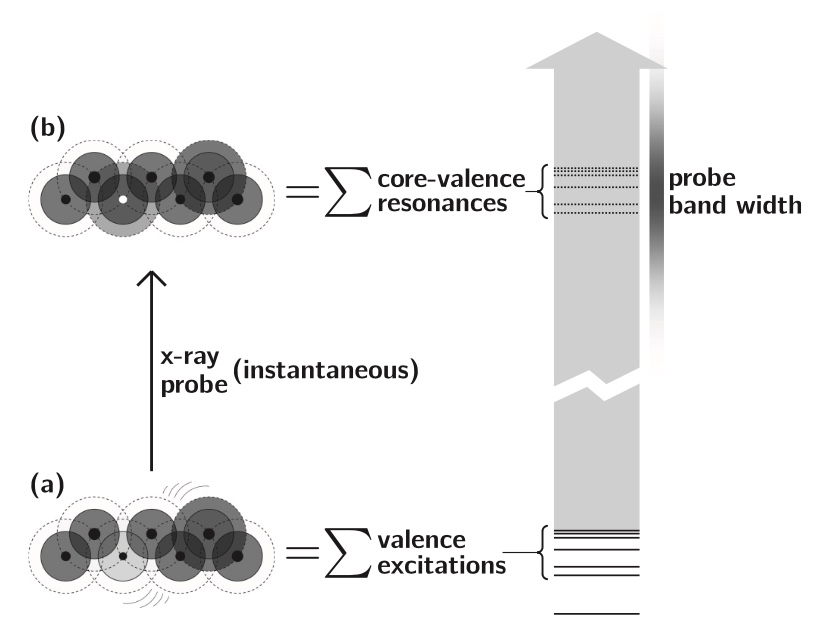
|
Numerical experiments are performed using a recently published formalism [Phys. Rev. A 88, 013419 (2013)] for computing the transient absorption of an attosecond x-ray probe by a molecule in a nonstationary valence- excited state. This study makes use of an all-electron correlated electronic-structure model to compute electronic dynamics ensuing after a localized excitation on a model chromophore group. Simulated absorption of a delayed attosecond pulse is then used to investigate the presence of an extra valence electron or vacancy around atoms of a given element as a function of time, by tuning the carrier frequency to the associated core-valence energy gap. We show correlations between the predicted absorption of such pulses and visualizations of the particle and hole locations in test molecules. Given the strong role played by the relative orientation of the molecules and the probe polarization, results are presented for a few different alignment schemes. For the molecules studied, effective pump-induced alignment is sufficient to recover easily interpreted information.
|
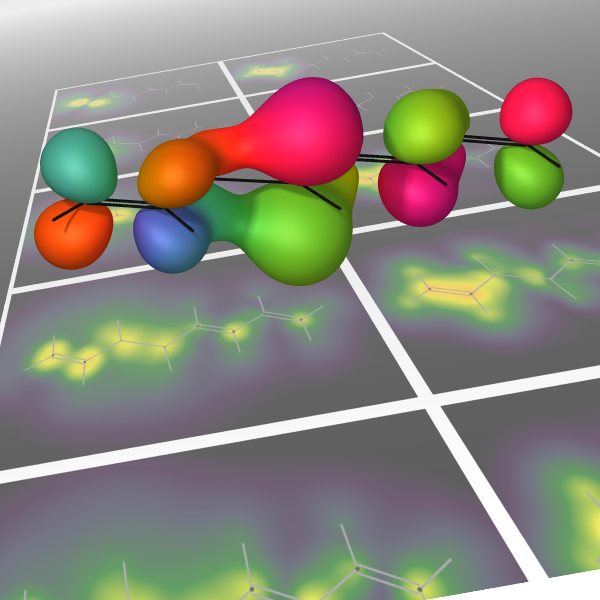
|
As experimental techniques begin to probe electronic motions in increasing detail, the need is arising for compact and informative visualisations of simulations of such processes. The inherent challenge is that a full many-electron wavefunction is a high-dimensional object, representing the complicated correlations of strongly repulsive bodies in a small molecular volume. A general procedure is needed to distill this to a smaller amount of information that does not rely on any specific level of approximation. The result should allow for easy and intuitive interpretation while drawing out nontrivial aspects of the underlying many-body dynamics, such as the complex phase information inherent of a nonstationary state. Current visualisation schemes based on physical observables or the qualitative information contained in simple wavefunctions, such as time-dependent configuration-interaction-singles (TD-CIS) and time-dependent self-consistent-field (TD-SCF), are discussed. This information is compared to an analysis based on the one-body reduced density operator (1-RDO), which is well-defined for general wavefunctions. It is seen that the distinction between two paradigms of many-body dynamics, electron transport and energy transport, is reflected in the coherences of a difference-1-RDO, or lack thereof.
|
Invited article, author profile: pg. 12 of same issue.
  Also the cover article Also the cover article
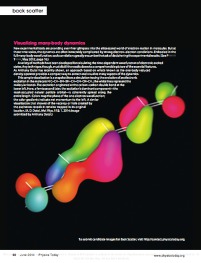  An image from this article was featured as the "back scatter" in Physics Today, Phys. Today 67-6 68 (2014). An image from this article was featured as the "back scatter" in Physics Today, Phys. Today 67-6 68 (2014).
|

|
Anticipating the experimental realization of attosecond pulses with photon energies of a few hundred eV to 1 keV, we have developed a formalism that connects the evolution of a UV-pumped nonstationary electronic state to an x-ray probe signal, using the one-electron reduced density operator. The electronic states we wish to follow evolve on time scales of a few femtoseconds, and the valence occupancy structure of these states can be probed, resolved in both space and time, by taking advantage of the inherent locality of core–valence transitions and the comparatively short time scale on which they can be produced. The time-dependent reduced density operator is an intuitively simple quantity, representing the dynamic occupancy structure of the valence levels, but it is well defined for an arbitrary many-body state. This article outlines the connection between the complexities of many-body theory and an intuitive picture of dynamic local orbital occupancy.
|

|
Attenuated second-order Møller-Plesset perturbation theory (MP2) within the finite aug-cc-pVTZ (aTZ) basis set is developed for inter- and intra-molecular non-bonded interactions. A single attenuation parameter is optimized on the S66 database of 66 intermolecular interactions, leading to a very large RMS error reduction by a factor of greater than 5 relative to standard MP2/aTZ. Attenuation introduces an error of opposite sign to basis set superposition error (BSSE) and overestimation of dispersion inter- actions in finite basis MP2. A variety of tests including the S22 set, conformer energies of peptides, alkanes, sugars, sulfate-water clusters, and the coronene dimer establish the transferability of the MP2(terfc, aTZ) model to other inter and intra-molecular interactions. Direct comparisons against attenuation in the smaller aug-cc-pVDZ basis shows that MP2(terfc, aTZ) often significantly outperforms MP2(terfc, aDZ), although at higher computational cost. MP2(terfc, aDZ) and MP2(terfc, aTZ) often outperform MP2 at the complete basis set limit. Comparison of the two attenuated MP2 models against each other and against attenuation using non-augmented basis sets gives insight into the error cancellation responsible for their remarkable success.
|
Publications prior to University of the Pacific
-
A. D. Dutoi and L. S. Cederbaum
"An Excited Electron Avoiding a Positive Charge"
J. Phys. Chem. Lett. 2 2300 (2011)
Highlighted in "News & Views" Nat. Chem. 4 8 (2012)
-
A. D. Dutoi, M. Wormit and L. S. Cederbaum
"Ultrafast Charge Separation Driven by Differential Particle and Hole Mobilities"
J. Chem. Phys. 134 024303 (2011)
Figure from this article reproduced in Nat. Photonics 8 165 (2014)
-
A. D. Dutoi, L. S. Cederbaum, M. Wormit, J. H. Starcke and A. Dreuw
"Tracing Molecular Electronic Excitation Dynamics in Real Time and Space"
J. Chem. Phys. 132 144302 (2010)
-
A. Dreuw, J. Plötner, M. Wormit, M. Head-Gordon and A. D. Dutoi
"An Additive Long-range Potential to Correct for the Charge-transfer Failure of Time-dependent Density Functional Theory"
in Progress in Physical Chemistry ed. F. M. Dolg, v. 3, p. 21 (Oldenbourg, München, 2010)
-
A. Dreuw, J. Plötner, M. Wormit, M. Head-Gordon and A. D. Dutoi
"An Additive Long-range Potential to Correct for the Charge-transfer Failure of Time-dependent Density Functional Theory"
Z. Phys. Chem. 224 311 (2010)
-
S. Ramakrishna, P. A. J. Sherrat, A. D. Dutoi and T. Seideman
"Origin and Implication of Ellipticity in High-order Harmonic Generation from Aligned Molecules"
Phys. Rev. A 81 021802 (2010)
-
J. A. Parkhill, J.-D. Chai, A. D. Dutoi, and M. Head-Gordon
"The Exchange Energy of a Uniform Electron Gas Experiencing a New, Flexible Range Separation"
Chem. Phys. Lett. 478 283 (2009)
-
A. D. Dutoi and M. Head-Gordon
"A Study of the Effect of Attenuation Curvature on Molecular Correlation Energies by Introducing an Explicit Cut-off Radius into Two-electron Integrals"
J. Phys. Chem. A 112 2110 (2008)
-
Y. Shao, L. F. Molnar, Y. Jung, J. Kussmann, C. Ochsenfeld, S. T. Brown, A. T. B. Gilbert, L. V. Slipchenko, S. V. Levchenko, D. P. O'Neill, R. A. DiStasio Jr., R. C. Lochan, T. Wang, G. J. O. Beran, N. A. Besley, J. M. Herbert, C. Y. Lin, T. Van Voorhis, S. H. Chien, A. Sodt, R. P. Steele, V. A. Rassolov, P. E. Maslen, P. P. Korambath, R. D. Adamson, B. Austin, J. Baker, E. F. C. Byrd, H. Dachsel, R. J. Doerksen, A. Dreuw, B. D. Dunietz, A. D. Dutoi, T. R. Furlani, S. R. Gwaltney, A. Heyden, S. Hirata, C.-P. Hsu, G. Kedziora, R. Z. Khalliulin, P. Klunzinger, A. M. Lee, M. S. Lee, W. Liang, I. Lotan, N. Nair, B. Peters, E. I. Proynov, P. A. Pieniazek, Y. M. Rhee, J. Ritchie, E. Rosta, C. D. Sherrill, A. C. Simmonett, J. E. Subotnik, H. L. Woodcock III, W. Zhang, A. T. Bell, A. K. Chakraborty, D. M. Chipman, F. J. Keil, A. Warshel, W. J. Hehre, H. F. Schaefer III, J. Kong, A. I. Krylov, P. M. W. Gill and M. Head-Gordon
"Advances in Methods and Algorithms in a Modern Quantum Chemistry Program Package"
Phys. Chem. Chem. Phys. 8 3172 (2006)
-
A. D. Dutoi and M. Head-Gordon
"Self-interaction Error of Local Density Functionals for Alkali-halide Dissociation"
Chem. Phys. Lett. 422 230 (2006)
-
J. E. Subotnik, A. D. Dutoi and M. Head-Gordon
"Fast, Localized, Orthonormal Virtual Orbitals which Depend Smoothly on Nuclear Coordinates"
J. Chem. Phys. 123 114108 (2005)
-
A. Aspuru-Guzik*, A. D. Dutoi*, P. J. Love and M. Head-Gordon
"Simulated Quantum Computation of Molecular Energies"
Science 309 1704 (2005)
*equal authorship
-
P. E. Maslen, A. D. Dutoi, M. S. Lee, Y. Shao and M. Head-Gordon
"Accurate Local Approximations to the Triples Correlation Energy: Formulation, Implementation and Tests of 5th-order Scaling Models"
Mol. Phys. 103 425 (2005)
-
A. D. Dutoi, Y. Jung and M. Head-Gordon
"An Orbital-based Definition of Radical and Multiradical Character"
J. Phys. Chem. A 108 10270 (2004)
-
Y. Jung, R. C. Lochan, A. D. Dutoi and M. Head-Gordon
"Scaled Opposite-spin Second-order Møller–Plesset Correlation Energy: An Economical Electronic Structure Method"
J. Chem. Phys. 121 9793 (2004)
-
P. Botschwina, T. Dutoi, M. Mladenovic, R. Oswald, S. Schmatz and H. Stoll
"Theoretical Investigations of Proton-bound Cluster Ions"
Faraday Discuss. 118 433 (2001)
-
R. F. See, A. D. Dutoi, K. W. McConnell and R. M. Naylor
"Geometry of Simple Molecules: Nonbonded Interactions and Not-bonding Orbitals Primarily Determine Observed Geometries"
J. Am. Chem. Soc. 123 2839 (2001)
-
R. F. See, A. D. Dutoi, J. C. Fettinger, P. J. Nicastro and J. W. Ziller
"The Crystal Structures of (p-ClPh)3PO and (p-OMePh)3PO, Including an Analysis of the P-O Bond in Triarylphosphine Oxides"
J. Chem. Crystallogr. 28 893 (1998)
|
 go to UOP homepage
go to UOP homepage
 go to UOP homepage
go to UOP homepage
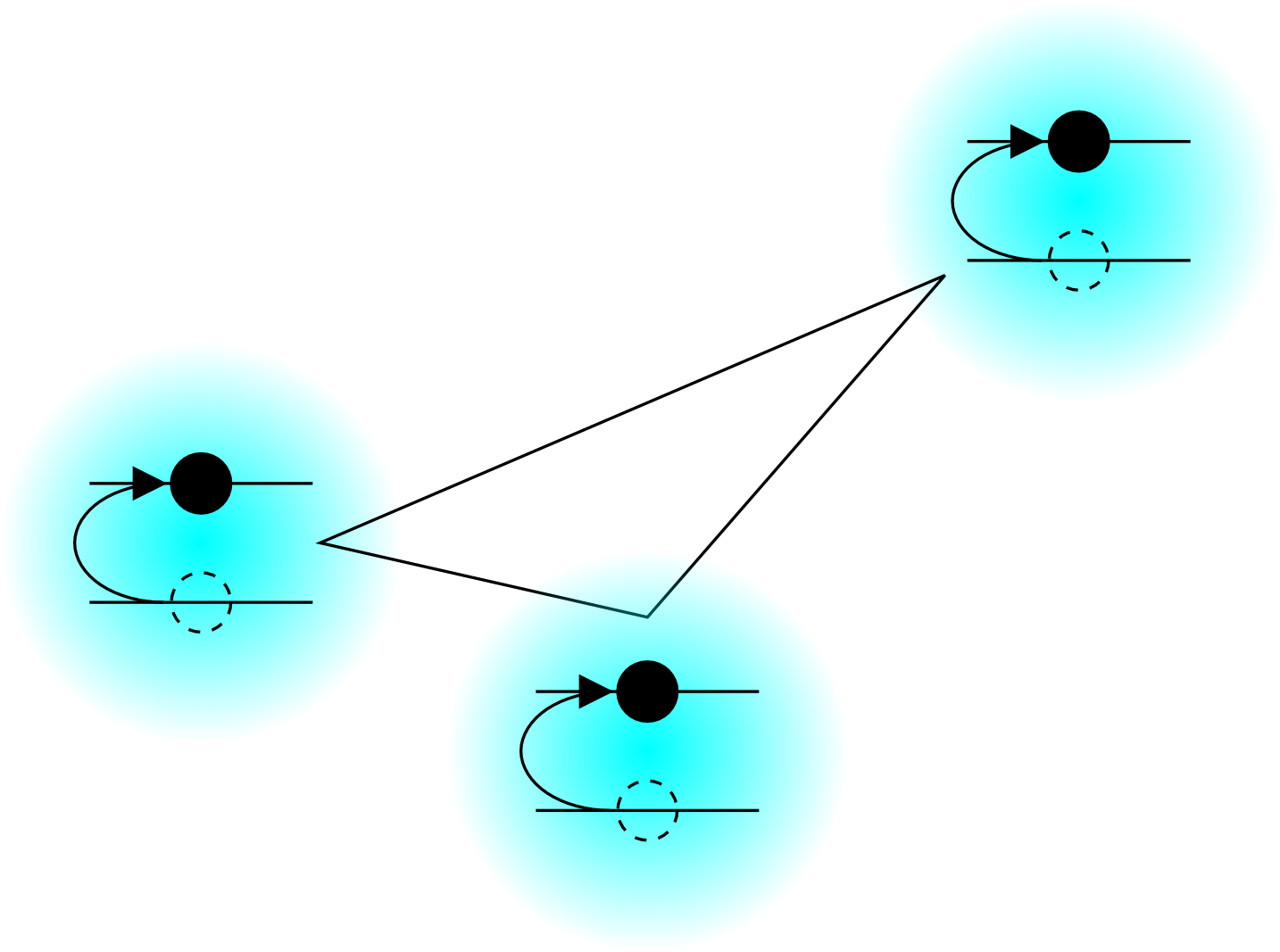 © Copyright 2012–2025
© Copyright 2012–2025